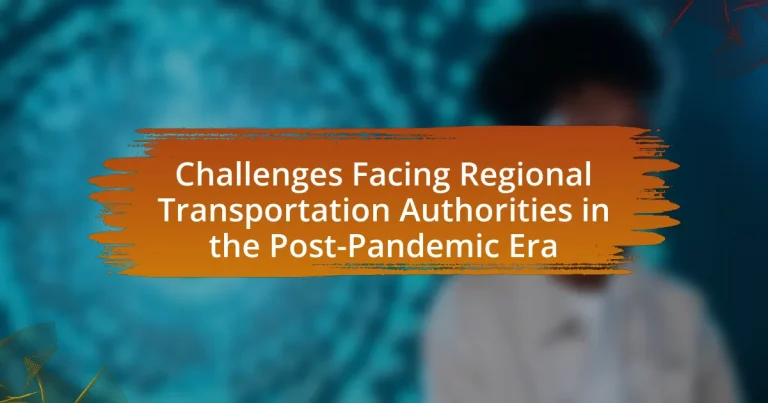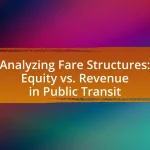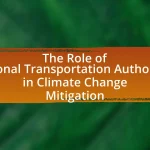Regional transportation authorities are currently facing significant challenges in the post-pandemic era, including reduced ridership, budget constraints, and the need for enhanced safety measures. The COVID-19 pandemic has led to a dramatic decline in fare revenue and increased operational costs, prompting authorities to consider service cuts and fare increases. Additionally, shifts in ridership patterns, workforce shortages, and the necessity for technological advancements further complicate recovery efforts. This article examines the implications of these challenges, the strategies being implemented to address funding shortfalls, and the innovative practices being adopted to enhance service reliability and operational efficiency in regional transportation systems.
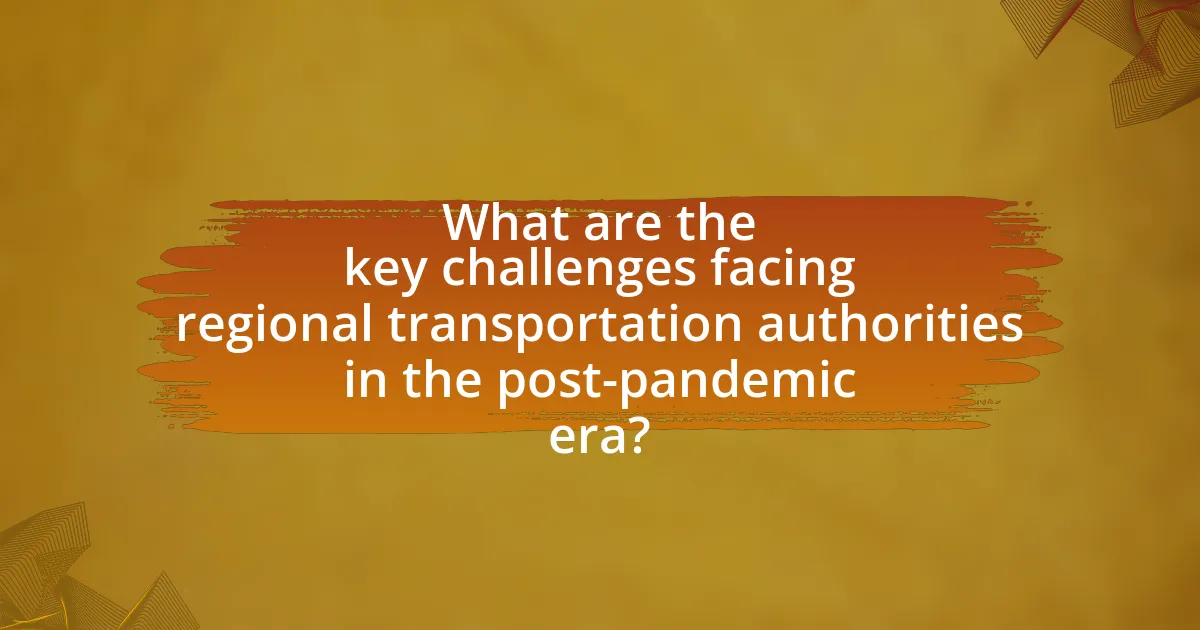
What are the key challenges facing regional transportation authorities in the post-pandemic era?
Regional transportation authorities face several key challenges in the post-pandemic era, including reduced ridership, budget constraints, and the need for enhanced safety measures. Reduced ridership has been a significant issue, with many commuters opting for remote work or alternative transportation methods, leading to a decline in fare revenue. Budget constraints have intensified as federal and state funding sources have been impacted by the economic downturn, forcing authorities to make difficult decisions regarding service levels and infrastructure investments. Additionally, the need for enhanced safety measures, such as improved sanitation protocols and social distancing practices, has increased operational costs and necessitated changes in service delivery. These challenges require regional transportation authorities to adapt quickly to changing circumstances while ensuring reliable and safe transit options for their communities.
How has the COVID-19 pandemic impacted regional transportation systems?
The COVID-19 pandemic has significantly disrupted regional transportation systems by causing a dramatic decline in ridership and revenue. For instance, public transit systems in major cities like New York and San Francisco reported ridership drops of over 90% during peak lockdown periods, leading to severe financial shortfalls. Additionally, many regional transportation authorities faced increased operational costs due to enhanced sanitation measures and the need for social distancing protocols. This combination of reduced income and increased expenses has forced many systems to consider service cuts and fare increases, further complicating their recovery efforts in the post-pandemic era.
What changes in ridership patterns have emerged post-pandemic?
Post-pandemic ridership patterns have shifted significantly, with a notable decline in public transit usage during peak commuting hours. Many commuters have adopted flexible work arrangements, leading to reduced demand for traditional rush hour services. According to a report by the American Public Transportation Association, ridership levels in major cities have remained approximately 50% lower than pre-pandemic levels, indicating a lasting impact on travel behavior. Additionally, there has been an increase in off-peak travel and a rise in the use of alternative transportation modes, such as biking and walking, as individuals seek to avoid crowded transit environments.
How have funding sources for transportation authorities been affected?
Funding sources for transportation authorities have been significantly affected due to reduced ridership and decreased tax revenues during the post-pandemic era. Many transportation authorities, which traditionally relied on fare collections and sales taxes, experienced sharp declines in income as public transit usage plummeted by as much as 80% in some regions. This financial strain has led to budget shortfalls, prompting authorities to seek alternative funding mechanisms, such as federal aid, which has been bolstered by stimulus packages like the American Rescue Plan that allocated $30 billion to support public transit systems.
What operational challenges do regional transportation authorities face now?
Regional transportation authorities currently face significant operational challenges, including reduced ridership, budget constraints, and workforce shortages. The COVID-19 pandemic led to a dramatic decline in public transit usage, with many authorities reporting ridership drops of over 70% at the peak of the crisis, which has resulted in decreased fare revenues. Additionally, many regional authorities are grappling with budget shortfalls due to increased operational costs and the need for enhanced safety measures, while simultaneously facing pressure to maintain service levels. Workforce shortages have also emerged as a critical issue, with many transit workers leaving the industry during the pandemic, leading to difficulties in staffing and service reliability. These challenges collectively hinder the ability of regional transportation authorities to effectively meet the mobility needs of their communities.
How has workforce availability changed in the transportation sector?
Workforce availability in the transportation sector has significantly decreased since the onset of the COVID-19 pandemic. The American Public Transportation Association reported a 40% reduction in workforce numbers due to layoffs and early retirements, exacerbated by health concerns and changing job preferences. This decline has led to operational challenges, including reduced service frequency and increased difficulty in hiring qualified personnel, as many workers have shifted to other industries or opted for remote work opportunities.
What safety protocols are necessary to regain public trust?
To regain public trust, regional transportation authorities must implement comprehensive safety protocols that include enhanced sanitation measures, mandatory mask-wearing, and social distancing guidelines. Enhanced sanitation measures, such as frequent cleaning of vehicles and stations, have been shown to reduce the transmission of pathogens, as evidenced by studies indicating that regular disinfection can lower infection rates in public spaces. Mandatory mask-wearing policies, supported by health organizations, help mitigate the spread of respiratory viruses, while social distancing guidelines ensure that passengers maintain safe distances, further reducing the risk of contagion. Collectively, these protocols not only address immediate health concerns but also demonstrate a commitment to passenger safety, which is crucial for rebuilding public confidence in transportation systems post-pandemic.
What technological challenges are regional transportation authorities encountering?
Regional transportation authorities are encountering significant technological challenges, including outdated infrastructure, integration of new technologies, and cybersecurity threats. Outdated infrastructure hampers the adoption of modern solutions, as many systems rely on legacy technologies that are not compatible with newer innovations. The integration of new technologies, such as real-time data analytics and smart transit systems, poses difficulties in terms of interoperability and requires substantial investment. Additionally, cybersecurity threats have increased as transportation systems become more digitized, necessitating robust security measures to protect sensitive data and ensure operational continuity. These challenges are critical as authorities strive to enhance efficiency and service quality in the post-pandemic era.
How can technology be leveraged to improve service delivery?
Technology can be leveraged to improve service delivery by implementing real-time data analytics and mobile applications. Real-time data analytics allows transportation authorities to monitor traffic patterns, optimize routes, and adjust schedules dynamically, leading to more efficient service. For instance, cities that have adopted smart traffic management systems have reported reductions in congestion by up to 30%, enhancing overall service delivery. Mobile applications enable users to access real-time information about transit schedules, delays, and alternative routes, improving user experience and satisfaction. According to a study by the American Public Transportation Association, agencies that utilize mobile technology see a 20% increase in ridership, demonstrating the effectiveness of technology in enhancing service delivery.
What barriers exist in adopting new technologies in transportation?
Barriers in adopting new technologies in transportation include high costs, regulatory challenges, and resistance to change. High costs can deter investment in new technologies, as seen in the implementation of electric vehicle infrastructure, which requires significant upfront capital. Regulatory challenges arise from outdated policies that do not accommodate innovative solutions, such as autonomous vehicles, which face stringent safety regulations. Additionally, resistance to change is prevalent among stakeholders, including transportation authorities and the public, who may be hesitant to embrace new systems due to concerns about reliability and job displacement. These factors collectively hinder the effective integration of advanced technologies in the transportation sector.
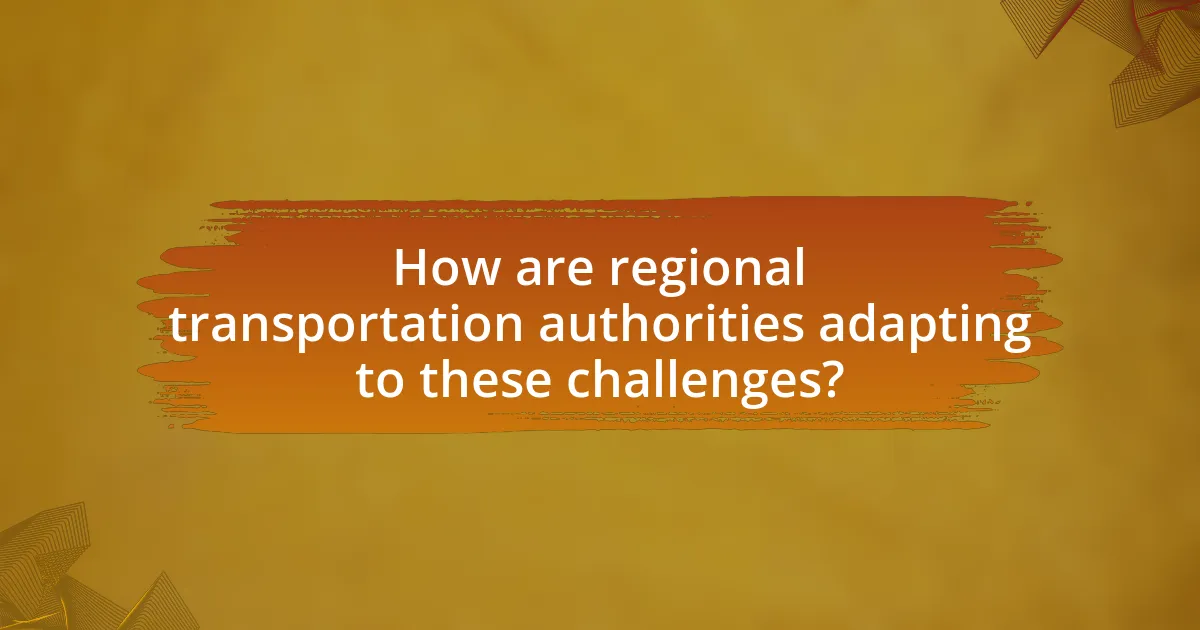
How are regional transportation authorities adapting to these challenges?
Regional transportation authorities are adapting to challenges by implementing enhanced safety protocols, increasing service flexibility, and investing in technology. For instance, many authorities have adopted contactless payment systems and improved sanitation measures to ensure passenger safety, which is crucial in the post-pandemic context. Additionally, they are adjusting service schedules and routes based on real-time demand data to better meet the needs of commuters, reflecting a shift towards more responsive transportation solutions. Investments in technology, such as mobile apps for real-time tracking and communication, further enhance user experience and operational efficiency. These adaptations are essential for rebuilding public trust and encouraging ridership in a changed transportation landscape.
What strategies are being implemented to address funding shortfalls?
Regional transportation authorities are implementing several strategies to address funding shortfalls, including diversifying revenue sources, increasing public-private partnerships, and enhancing fare collection systems. Diversifying revenue sources involves seeking alternative funding through grants, local taxes, and dedicated funding measures, which can provide more stable financial support. Public-private partnerships allow for collaboration with private entities to share costs and resources, thereby alleviating financial burdens. Additionally, enhancing fare collection systems through technology upgrades can improve efficiency and increase revenue from ridership. These strategies are essential for maintaining and improving transportation services in the post-pandemic era.
How can partnerships with private sectors enhance funding opportunities?
Partnerships with private sectors can enhance funding opportunities by leveraging additional financial resources and expertise that public entities may lack. These collaborations often result in innovative funding models, such as public-private partnerships (PPPs), which can attract investment for infrastructure projects. For instance, a study by the World Bank indicates that PPPs can reduce project costs by up to 30% and expedite project delivery, thereby making funding more accessible for regional transportation authorities. Additionally, private sector partners can provide not only capital but also operational efficiencies and technological advancements, further increasing the viability and attractiveness of funding proposals.
What role does government support play in financial recovery?
Government support plays a crucial role in financial recovery by providing essential funding and resources to stabilize and revitalize economies. During crises, such as the COVID-19 pandemic, government interventions, including grants, loans, and subsidies, help regional transportation authorities maintain operations, retain employees, and invest in infrastructure improvements. For instance, the Federal Transit Administration allocated $25 billion in emergency relief to public transit agencies in the U.S. in 2020, enabling them to address revenue shortfalls and continue essential services. This financial backing is vital for ensuring that transportation systems can recover and adapt to changing demands in the post-pandemic era.
How are transportation authorities improving operational efficiency?
Transportation authorities are improving operational efficiency by implementing advanced technologies such as real-time data analytics and automated systems. These technologies enable better resource allocation, enhance service reliability, and optimize route planning. For instance, the use of GPS tracking and predictive analytics allows authorities to monitor traffic patterns and adjust services accordingly, resulting in a reported 20% reduction in delays in several metropolitan areas. Additionally, integrating mobile applications for customer engagement has increased ridership by providing users with timely information and improved service accessibility.
What innovative practices are being adopted to enhance service reliability?
Innovative practices being adopted to enhance service reliability include the implementation of real-time data analytics and predictive maintenance technologies. These practices allow transportation authorities to monitor system performance continuously and anticipate potential failures before they occur. For instance, the use of Internet of Things (IoT) sensors on vehicles and infrastructure enables the collection of data that can be analyzed to optimize routes and schedules, thereby reducing delays. Additionally, predictive maintenance, which utilizes machine learning algorithms to analyze historical data, helps in scheduling timely repairs, thus minimizing service disruptions. According to a study by the Transportation Research Board, agencies that adopted these technologies reported a 20% improvement in service reliability metrics.
How can workforce training programs be revamped for better outcomes?
Workforce training programs can be revamped for better outcomes by integrating technology-driven learning methods and tailoring content to specific industry needs. Implementing online platforms and virtual simulations allows for flexible, accessible training that can adapt to various learning styles. Additionally, aligning training with real-world applications, such as hands-on projects and partnerships with local businesses, enhances relevance and engagement. Research indicates that organizations utilizing blended learning approaches see a 60% improvement in retention rates compared to traditional methods. This evidence supports the effectiveness of modernizing training programs to meet the evolving demands of the workforce, particularly in the context of regional transportation authorities adapting to post-pandemic challenges.
What technological advancements are being pursued by transportation authorities?
Transportation authorities are pursuing advancements in smart traffic management systems, electric and autonomous vehicles, and integrated mobility platforms. Smart traffic management systems utilize real-time data analytics to optimize traffic flow and reduce congestion, which is crucial in urban areas facing increased demand post-pandemic. Electric and autonomous vehicles are being developed to enhance sustainability and safety, with many authorities investing in infrastructure to support electric charging stations and testing autonomous transit options. Integrated mobility platforms aim to provide seamless transportation experiences by combining various modes of transport, such as buses, trains, and ridesharing services, into a single accessible system, thereby improving efficiency and user convenience. These advancements are essential for addressing the evolving challenges in regional transportation systems.
How is data analytics being utilized to improve decision-making?
Data analytics is utilized to improve decision-making by providing actionable insights derived from large datasets, enabling transportation authorities to optimize operations and resource allocation. For instance, predictive analytics can forecast ridership trends based on historical data, allowing authorities to adjust service levels accordingly. A study by the American Public Transportation Association found that agencies using data analytics reported a 20% increase in operational efficiency. By analyzing real-time data on traffic patterns and passenger behavior, authorities can make informed decisions that enhance service reliability and customer satisfaction.
What are the implications of smart transportation systems for the future?
Smart transportation systems will significantly enhance efficiency, safety, and sustainability in future urban mobility. These systems utilize advanced technologies such as IoT, AI, and big data analytics to optimize traffic flow, reduce congestion, and improve public transport services. For instance, a study by the International Transport Forum indicates that smart traffic management can reduce travel times by up to 30% and decrease emissions by 20%. Furthermore, the integration of autonomous vehicles into smart transportation networks is projected to lower accident rates, as human error is responsible for approximately 94% of traffic accidents. Overall, the implications of smart transportation systems include improved urban infrastructure, enhanced user experience, and a substantial reduction in environmental impact.
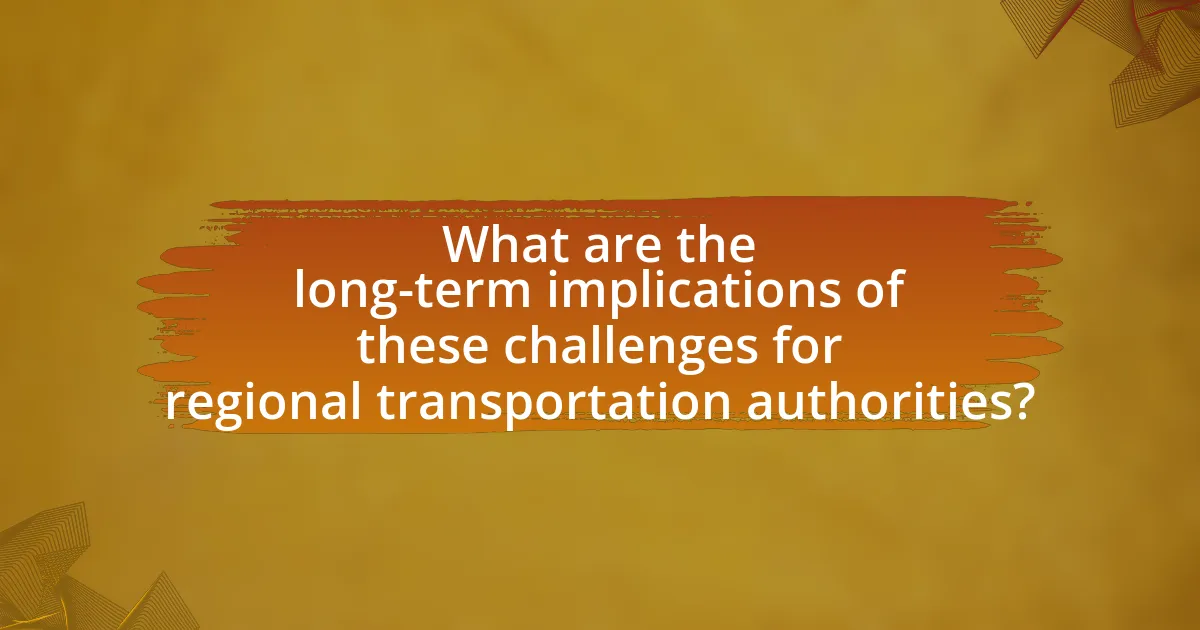
What are the long-term implications of these challenges for regional transportation authorities?
The long-term implications of challenges facing regional transportation authorities include potential funding shortfalls, decreased ridership, and increased operational costs. These authorities may experience a sustained decline in revenue due to reduced public transit usage, as many commuters have shifted to remote work or alternative transportation methods. For instance, a report from the American Public Transportation Association indicated that public transit ridership dropped by over 70% during the peak of the pandemic, leading to significant budget deficits. Additionally, the need for enhanced safety measures and infrastructure upgrades to accommodate health guidelines may further strain financial resources. Consequently, regional transportation authorities may face difficulties in maintaining service levels and investing in future projects, ultimately affecting regional mobility and economic recovery.
How will changes in public transportation affect urban planning?
Changes in public transportation will significantly influence urban planning by necessitating the redesign of infrastructure and land use policies. As cities adapt to shifts in commuting patterns, such as increased remote work and a preference for sustainable transport options, urban planners must prioritize accessibility and connectivity. For instance, a report by the American Public Transportation Association indicates that cities with robust public transit systems experience higher economic growth and reduced traffic congestion. Consequently, urban planning will increasingly focus on integrating mixed-use developments, enhancing public transit accessibility, and promoting walkable neighborhoods to accommodate these changes.
What trends in mobility might emerge as a result of these challenges?
Emerging trends in mobility as a result of challenges facing regional transportation authorities in the post-pandemic era include increased adoption of digital solutions, a shift towards micro-mobility options, and enhanced focus on sustainability. Digital solutions, such as mobile ticketing and real-time tracking, are being implemented to improve user experience and operational efficiency, reflecting a broader trend towards smart transportation systems. The rise of micro-mobility, including e-scooters and bike-sharing programs, addresses the need for flexible, short-distance travel options, particularly in urban areas where public transit may be less reliable. Additionally, there is a growing emphasis on sustainable transportation practices, driven by public demand for environmentally friendly options and government policies aimed at reducing carbon emissions. These trends are supported by data indicating that cities investing in sustainable transport infrastructure see increased ridership and reduced congestion.
How can regional transportation authorities prepare for future disruptions?
Regional transportation authorities can prepare for future disruptions by implementing robust contingency planning and investing in technology for real-time data analysis. Contingency planning involves developing comprehensive response strategies for various scenarios, such as pandemics or natural disasters, which can minimize service interruptions. For instance, the Federal Transit Administration emphasizes the importance of emergency preparedness plans that include communication protocols and resource allocation strategies. Additionally, investing in technology, such as predictive analytics and smart transportation systems, enables authorities to respond swiftly to emerging issues, as evidenced by cities that utilized data-driven approaches during the COVID-19 pandemic to adjust service levels effectively.
What best practices can regional transportation authorities adopt moving forward?
Regional transportation authorities can adopt data-driven decision-making as a best practice moving forward. By leveraging real-time data analytics, authorities can optimize routes, improve service frequency, and enhance overall operational efficiency. For instance, cities like Los Angeles have implemented data analytics to adjust bus routes based on passenger demand, resulting in a 15% increase in ridership. Additionally, integrating sustainable practices, such as electric vehicle adoption and promoting public transit use, can significantly reduce carbon emissions and improve air quality. Research from the American Public Transportation Association indicates that every $1 invested in public transit generates approximately $4 in economic returns, underscoring the importance of strategic investment in transportation infrastructure.
How can stakeholder engagement improve transportation planning?
Stakeholder engagement can significantly improve transportation planning by ensuring that the needs and preferences of the community are accurately reflected in the planning process. Engaging stakeholders, such as local residents, businesses, and government agencies, allows for the collection of diverse perspectives and valuable insights that can lead to more effective and inclusive transportation solutions. For instance, studies have shown that projects with strong stakeholder involvement are more likely to meet community needs and achieve higher satisfaction rates, as evidenced by the Federal Highway Administration’s report highlighting that public involvement can lead to better project outcomes and increased public trust.
What lessons can be learned from other regions facing similar challenges?
Regions facing similar challenges in post-pandemic transportation can learn the importance of flexibility and adaptability in service delivery. For instance, cities like New York and London have successfully implemented on-demand transit services to meet fluctuating ridership levels, demonstrating that adjusting service models can enhance efficiency and user satisfaction. Additionally, the integration of technology, such as real-time data analytics for route optimization, has proven effective in regions like Singapore, where data-driven decisions have improved operational performance and reduced costs. These examples highlight that embracing innovation and responsive strategies can significantly mitigate the challenges faced by transportation authorities in a post-pandemic context.
